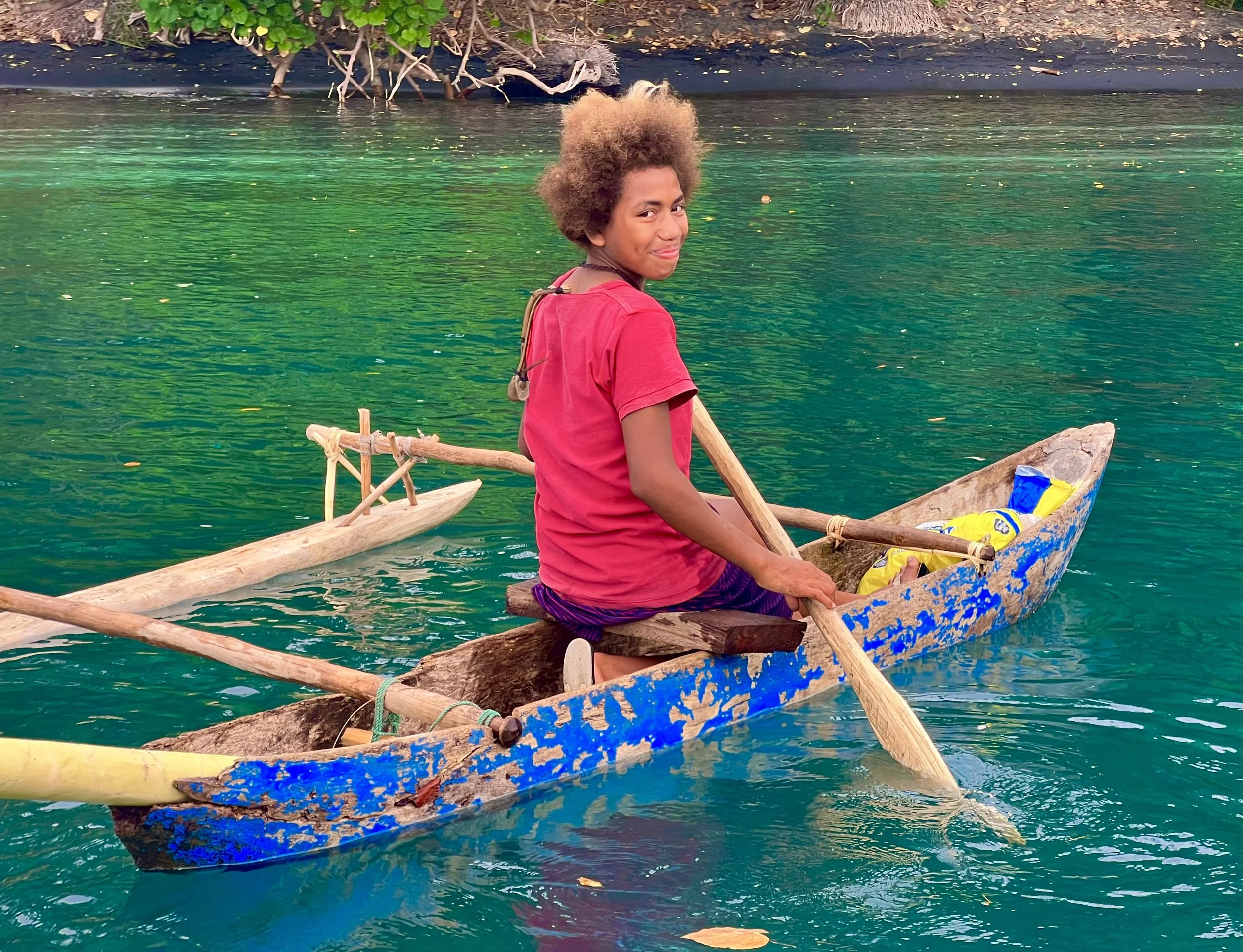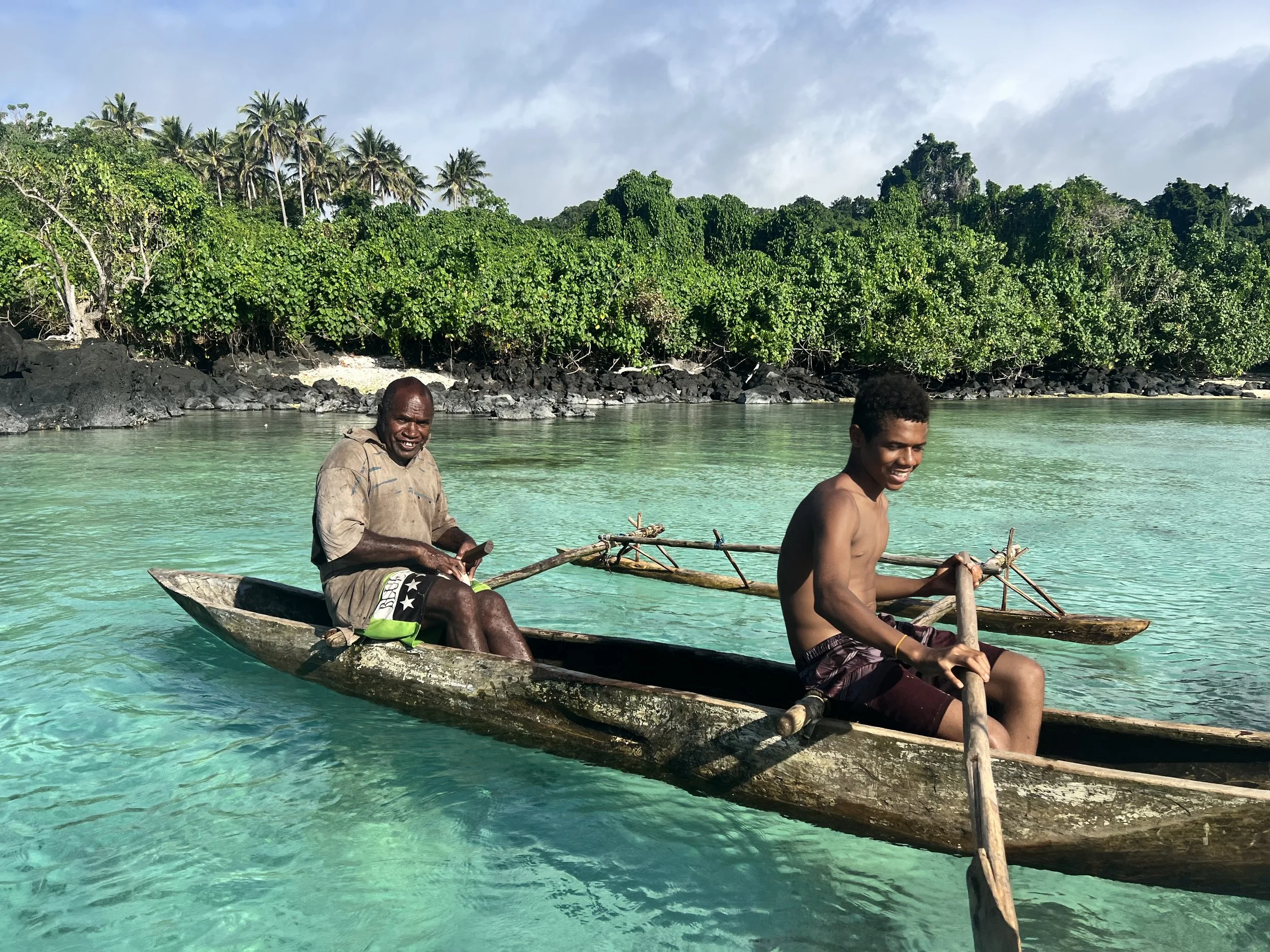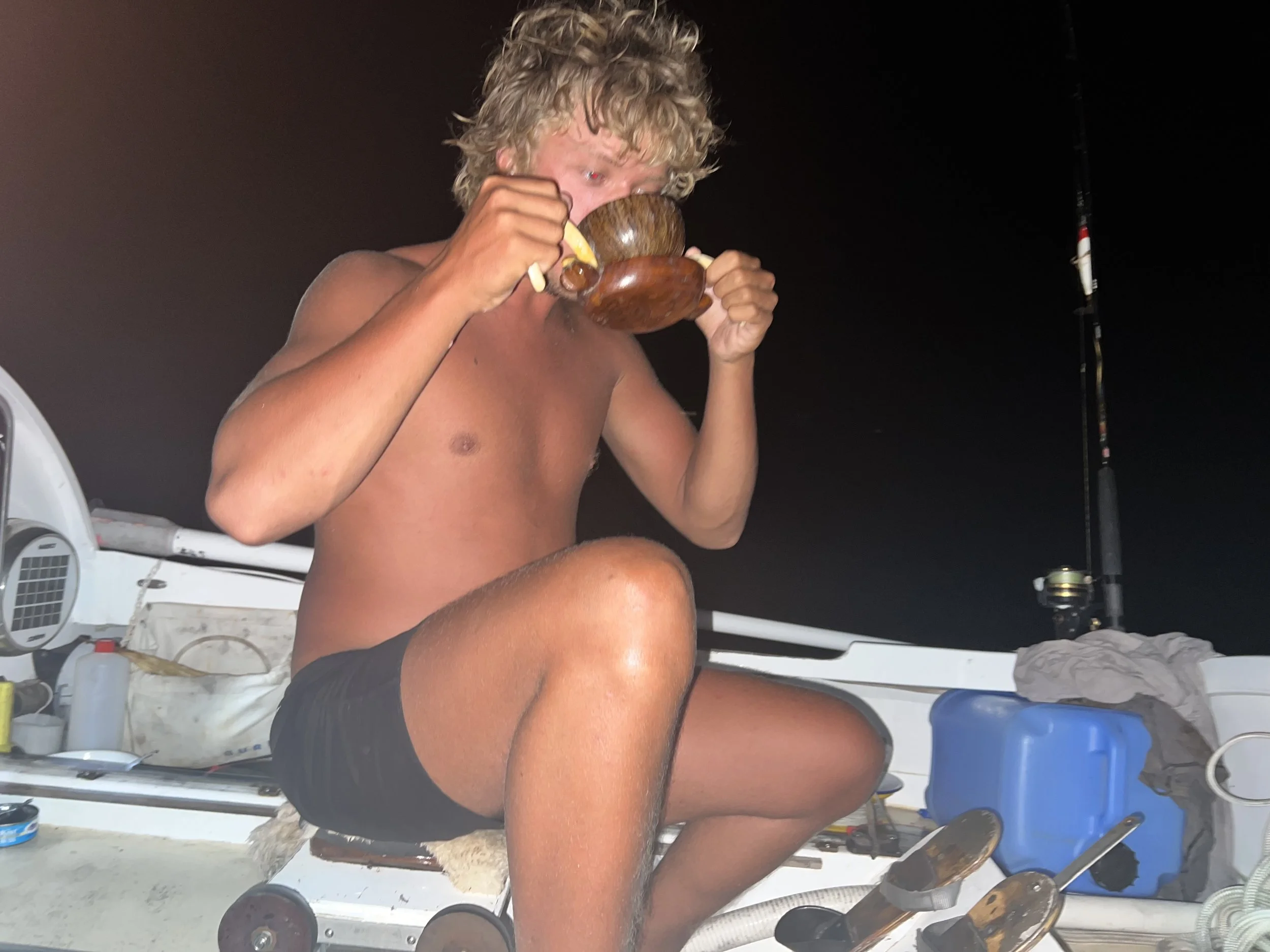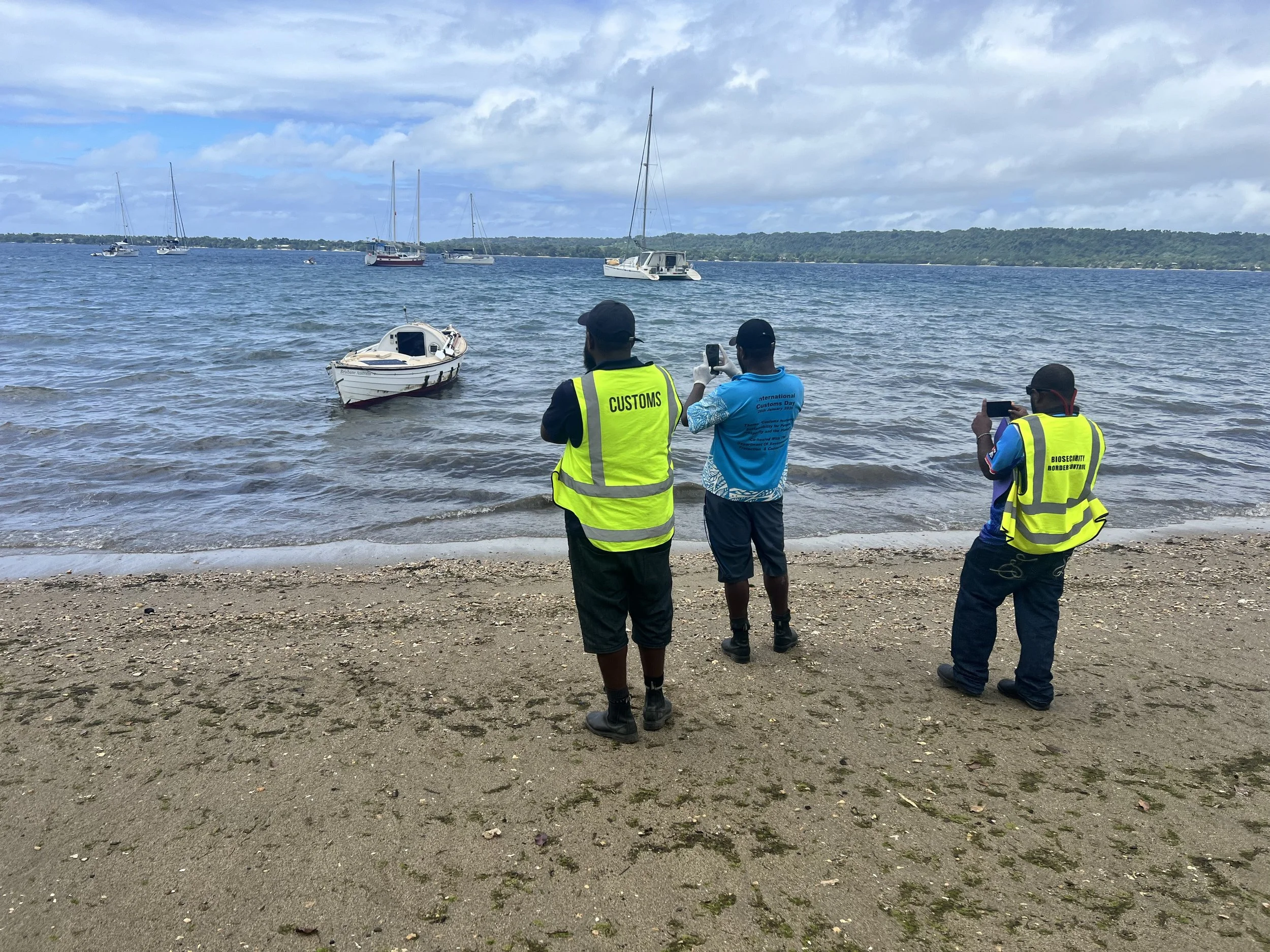Greetings from Vanuatu
At long last I can finally say ‘Greetings from Vanuatu’. Yesterday, 73 days after departing Samoa, and 19 days after arriving to Vanuatu, I was finally able to clear into the port of Luganville and step ashore. What an adventure it has been! Of course, there are many tales to tell, and it’s hard to know where to begin, but perhaps day 50 will be a good place to start.
On day 50 I found myself fast approaching the enchanting archipelago of Vanuatu. At that stage I had no plans to stop, but thought perhaps I could use the lee of the islands to my advantage to get some miles south. It all changed later that day when, after a few days of light breezes, once again, to my chagrin, the unusually strong south-easterly breeze came back in full force. I started to reassess my options. Maewo Island was no longer possible, and if I kept rowing I’d be blown north potentially into the Solomon Islands, I had to find shelter. Gaua Island lay 60 miles to the north-west, unfortunately, it’s not a port of entry, but I hoped that I could find an anchorage, stay aboard Maiwar, wait out the breeze, then keep going a few days later.
On the morning of day 52 I found myself fast approaching Gaua. It was close, I could see the coconut plantations, the dense jungle, and could smell the sweet smell of copra. The top of the active volcano was covered in cloud, the breeze was blowing strong, and I was rowing with all my might to make landfall before dark. I was filled with vigour and all my senses were alive to the world around me, my mind focused on one task and one task only- safely navigating my way into an anchorage on a poorly charted, windswept, volcanic island. At that stage I wasn’t even sure if it could be done - one wrong move and I would be carried away by the wind, or worse still, onto a rocky shore - but by God I was going to give it my best shot.
As the day wore on the breakers grew closer. By early afternoon I had rounded the northeastern tip of the island and begun to make my way along the northern side. By about 1400hrs the first pang of fear came in. I was rowing along, just outside the reef, the land was oh so close, yet completely inaccessible. I needed to find a place to anchor before dark, or else I would have no hope of stopping. At this stage I had seen no sign of civilisation, then, as I pulled on the oars, I spotted a thatch hut, a canoe on the beach inside the reef, and a small boy. I saw his little dark figure run up to the house, he had seen me. Next I saw a man emerge, then make his way to the canoe. They both got in and began to paddle. I stood up to get a better view, intrigued by their willingness. And then I saw it, an ever so small gap in the reef, an entrance into the surrounding calm water. Completely out of view from my seated position, I had rowed straight past it. I then made a split second decision, I put the rudder hard over, turned head into the breeze, and began to row back the way I came, just meters from the breaking waves. By this time the man and the boy in the canoe had positioned themselves at the mouth of the pass, waiting to guide me through. A few minutes later I was on the outside of the pass, the rudder was raised, and I was poised and ready. I took a deep breath and began to row. The coral underneath me was just inches away, the pass was no wider than my oar span, and my head was cranked, watching the man in canoe as he made silent hand signals - left thumb, right thumb, ease it up. A second later I was through the pass and into crystal clear, shallow water. I was intoxicated with the pure pleasure of a risky landfall after almost two months at sea.
I dropped my anchor and the canoe came along side. The man introduced himself as Victor, and his grandson as Felix. They seemed as bewildered as I was, they both sat there grinning and not saying a word - I was doing just the same. I looked to the shore and saw a woman clambering along the rocks while husking a coconut with a bush knife. Victor paddled to the shore, received the coconut and delivered to me. “My wife had tears in her eyes for you”, Victor said as he handed me the sweet drinking nut. I took a hearty gulp and quietly revelled in my unique situation.
Five days later, with the trades still strong, I found myself 10 miles to the west, anchored in the stunning Bushman’s Bay, outside a village of 40 people who live, just like Victor, without electricity, phone reception or road access. These people will paddle four hours each way to go to the shop. From where I sat in Maiwar’s cockpit I could see no sign of the modern world, the beach was home to dugout canoes, and the village was built wholly from the trees and palm leaves of the valley. Indeed it felt like stepping back in time. Of course, I was still unable to go ashore, but this was no hindrance, I soon became friends with plenty of the villagers, many of whom paddled out to Maiwar regularly to deliver me food. One evening, not long after the sun had set, I heard a knock on the boat. I stuck my head out of the cabin to see Father Zylas in his canoe. He spoke politely. “Excuse me Thomas, sorry to bother you but I have just come to inform you that Samuel and I will be returning to your boat in about an hour for a small kava drinking ceremony if this is alright with you”. I couldn’t help but smile “see you soon” I replied.
A little while later Zylas and Samuel returned with a bottle of fresh kava and a ceremonial drinking cup fashioned from half a coconut and two boar’s tusks. My two friends perched themselves on Maiwars aft deck while I sat on the sliding seat. Zylas said a few words, thanking me for stopping in Bushman’s Bay and welcoming me into the community, he then filled the cup and gave it to me. “Here you go Thomas, you must drink it all in one go”. And that I did. Thankfully, it was not as strong as I expected. The two men explained that all the men in the village drink kava every night, but it’s more of a ritual than an intoxicant. In a pleasantness that can only be had in the South Pacific, we talked the night away and returned each other’s smiles, my two friends smoking their bush tobacco contentedly.
Two days later the weather finally cleared and it was time to leave. Early one morning, with a cockpit full of juicy tropical fruit, I waved goodbye to the villagers on the beach, then, accompanied by my friend in his canoe, I rowed out of Bushman’s Bay and down the west side of Gaua.
Two and a half days later I had made it to the northernmost tip of Espirito Santo Island, my goal all along. I rounded Cape Nahoi just before dark, once again pulling my way along a rocky shore, made all the more exhilarating by the strong convergence of tides at the point. I rowed through small sharp waves, gusty breezes and a conglomorence of driftwood and logs. I then continued to row for the next two hours in complete darkness. Eventually I saw three lights on the shore, the only evidence of a settlement with over 1000 people. Gingerly I rowed towards the lights, I could hear the surf pounding on the gravel beach, the chart told me I had just rowed straight over a substantial island… When I was close to the beach I dropped my anchor but found no bottom. I then began to use my torch to signal the shore, I hoped a canoe would come out and show me where to anchor. For an hour I signalled the shore, three times I got a response, I heard children giggling on the beach, but nobody came out. Eventually, I found a rocky cove, and was greatly relieved to feel the anchor hit the bottom. I awoke the next day to a most beautiful little anchorage, canoes came out, and a man from the next village wanted to tow me to his village so they could be hosts!
The rest of my journey south along the west coast of Santo Island continued in much the same fashion. Every single village I passed, someone would launch a canoe and paddle out, just to ask me if I was okay. At every anchorage I found for the night I would be greeted and delivered fruit and coconuts. I even had one man paddle out to me in the afternoon, give me directions to the next village a mile down the coast, then proceed to row Maiwar the full distance while I sat in the cockpit eating fruit! The next morning I awoke as the sun came up to see 30 villagers sitting on the beach looking at me, and a big pile of mangoes next to the children. They were delivered to me by canoe and I was informed that the children had been up before sunrise collecting fruit for the white man in the little boat.
It is a mostly unforgiving coastline I was navigating, anchorages are few and far between, and the breeze is constantly on the nose. This means that once I began rowing in the morning, there was no stopping until dark. Thankfully, the breezes were light and my progress good. Unfortunately, my luck changed midway down the coast when I was hit with strong, gusty southerlies that were funnelling down through the mountains. For three days I left the village of Tasmate and rowed south, only to be pushed right back to the anchorage. I was getting nowhere. By this stage I had been in Vanuatu for two weeks without stepping ashore, not wanting to break the law. I had to get to Luganville to officially check in. Things were getting desperate. Then, out of nowhere, a German yacht arrived. The first yacht to anchor there in many years. I paddled out in a canoe and chatted to the owner. He seemed less than interested in towing me to Luganville but could be persuaded for a price! Two days later, Maiwar was under tow and we made our way slowly around the notorious southern cape of Santo and into the protected waters of Luganville. What a joy it was to drop anchor. Another two days later, on Monday, I stepped ashore for the first time, walked into the customs office, and explained that I had just arrived from Samoa in a rowing boat. This caused quite a stir, enough in fact for the customs and biosecurity teams to insist on an inspection of the boat. My long awaited entry into Vanuatu went by without a hitch.



